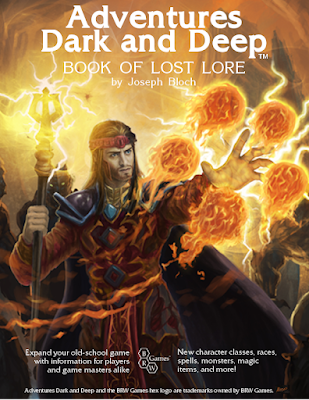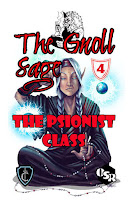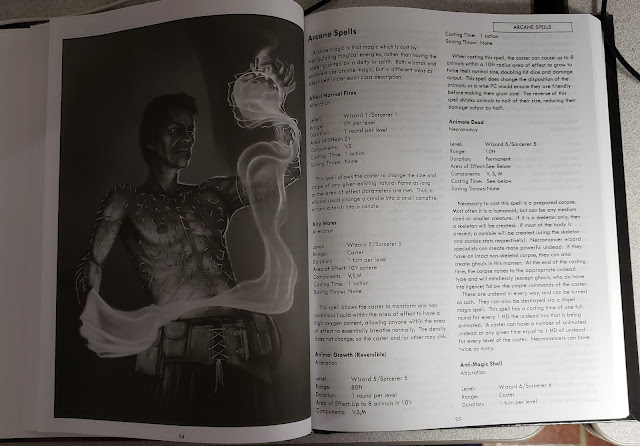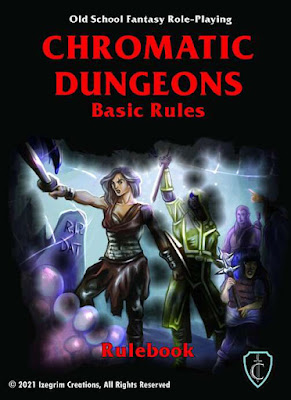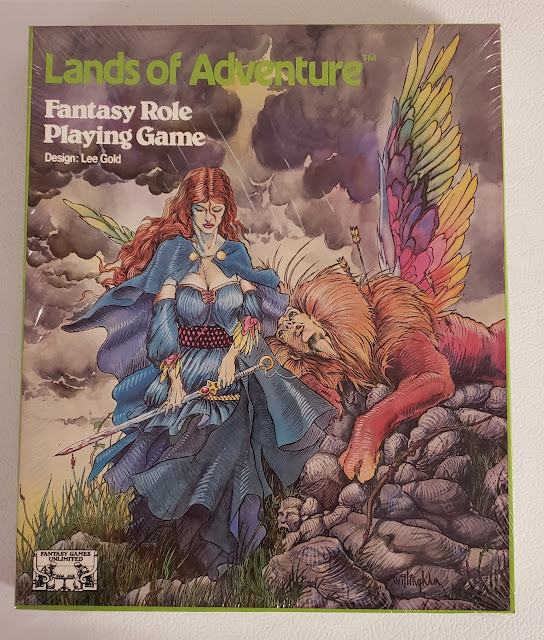Adventures Dark & Deep Book of Lost Lore
For this review, I am considering the Hardcover I received as a Kickstarter backer and the PDF from DriveThruRPG. BRW does their print fulfillment via DriveThru, so I conveniently have my PDFs where I expect them and I know what sort of product I am getting in terms of Print on Demand.
The book itself is 134 pages, full-color cover, and has black and white interior art. The layout and art are a tribute to the "2nd covers" of the AD&D 1st Edition line. So it looks nice with your original books and other OSR books designed the same way.
Like the Book of Lost Beasts, this book carries the Adventures Dark & Deep banner, but it is not made for that game. It is material from that game ported "Backwards" to the AD&D 1st Edition rules. So again like Book of Beasts, some of this material has been seen before, though not all in 1st Edition format/rules.
Much of the material does come from Bloch's "What If" game, Adventures Dark & Deep, and in particular, the Players Manual which itself was derived from BRW Games' very first product A Curious Volume of Forgotten Lore (now discontinued). This is all acknowledged in the Preface of the book. The selling point of this book is that it is all revised and edited for the "First Edition of the world's most popular RPG." Not to mention the layout now favors the 1st ed feel rather than the Adventures Dark & Deep feel.
Though as we move on you will see that the biggest comparison that needs to be made is this book to the AD&D Unearthed Arcana.
On to the book proper now.
This book is split between a Players' Section (close to 98 pages) and GMs' section (36 or so pages).
Players' Section
This section covers new races, classes, and spells among other topics that I will discuss.Up first, the new races. Here we are given three "new" races for player characters. These are the Centaur, the Forrest Gnome, and the Half-Drow, of which we get Human-Drow and Elf-Drow. Those unfamiliar with AD&D 1st ed might be surprised to see level limits and ability limits for the races. Some are pretty obvious, centaurs tend to be stronger but can't climb walls as a thief. Others are culture-based, drow women can advance more in most classes than their male counterparts due to their matriarchal society, but not as much as wizards since that class is not valued. While back in the day we really ignored all these rules in AD&D (and they do not exist in 21st Century D&D) they are consistent with the rules and anyone who plays AD&D 1st ed exclusively will take to these easy.
The races seem balanced enough. The centaur is a nice addition and one that really could go into AD&D well enough. I personally have never had a desire to play one, but they do seem to work. The forest gnome is also a good choice and a good option for people more familiar with 21st century D&D gnomes. The coverage of the half-drow is very interesting and the stand-out of the three. Given some other things I have crossed my awareness this past week or so I am wanting to try out a half-drow now. I will need to come back to this one later on.
Classes are likely the top feature of this book. They are also the ones that we have seen before. There are Bards, Jesters, Skalds, Blackguards, Mystics, Savants, and Mountebanks. Let me repeat. While we have seen these before in other BRW products they are presented here as 1st Edition characters classes and as subclasses of existing 1st Ed classes. Except the Bard, the Bard is it's own class with the Jester and Skald as sub-classes of the Bard. The Blackguard (or Anti-Paladin) is a subclass of the Cavalier to give you an idea where this book would "fit" into the AD&D 1st Ed lineup.
It should be noted is a usable single Bard class. No more advancing as a thief, fighter, and then druid to get to the bard, this is a straight out bard class. The bard also has some nice powers too. The mystic class seems closer to the BECMI/RC version than it does to the monk. It was also the focus of one of my very first "Class Struggles" features. I am a little surprised we didn't see versions of BRW Games' Necromancer, Witch, or Demonolater classes. Likey to keep these with the Adventures Dark & Deep game.
From Classes, we move on to Secondary Skills. AD&D 1st Ed has never really been about skills outside of what your character class can do. While back then I saw this as a problem, I am less inclined to think so now. Still, a good selection of secondary skills are listed here and how they can be used.
The next 35 or so pages are dedicated to new spells. Mostly these support the new magic-using classes, though some spells are cross-listed for other classes.
The last part of the player's section is given over to combat and new weapons and armor. The arms and armor described here do show an appreciated level of research. One that would have made Gary and his 6 pages of pole-arms very happy.
Game Masters' Section
This section is not as large but still has gems; figurative and literal.
Up first are some guidelines for social encounters including reactions. There are some alternate treasure rules that uses the same Treasure Type classification but breaks it down into different categories. Both the original system and this system can be used interchangeably, even within the same game, with the Game Master deciding what works better at the time.There are some new magic items, with updated tables to include them.
Finally some discussion on the game environment including ability checks.
Honestly, the only thing it is missing to be "Unearthed Arcana II" is an appendix on the gods of the Centaurs.
Some art has appeared before in other BRW books but all of it captures the Old-School gaming feel.
So. Who is this book for?
The obvious answer is for anyone that plays First Edition AD&D. It should work fine with OSRIC, since that cleaves so close to AD&D, but not sure if players of Advanced Labyrinth Lord or Old School Essentials Advanced will get the same benefits. For example, both of those other games have a Bard class that works about the same. That is not to say they would not get benefits from this book, it's just the base design principles are not 100% the same.
If you are a player of Adventures Dark & Deep then there is likely nothing new here for you. But if you have those books and still play Advanced Dungeons & Dragons first ed. then there is enough here for you even if you can convert easily between the two games.
If you play AD&D 1st ed then this is a great book and it will sit nicely on your shelf or on your table next to your other AD&D books.
One minor point, the book was not released under the OGL. Doesn't matter for play or use only if you wanted to reuse a class or spell elsewhere. Though given the use I have seen of the OGL over the last 20+ years this is also likely not an issue.

